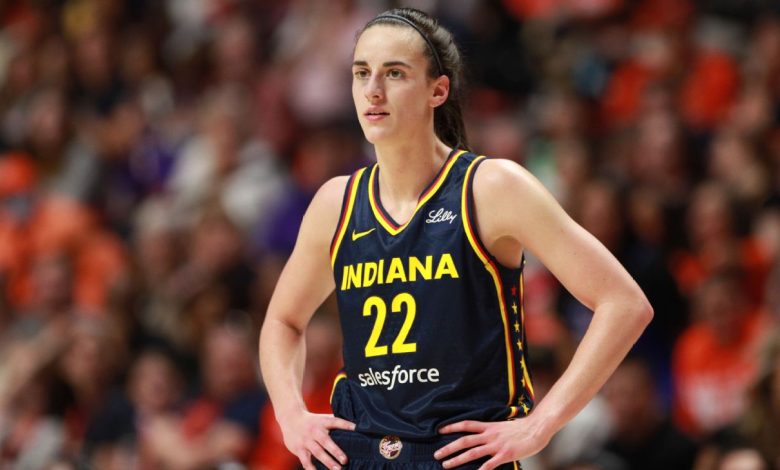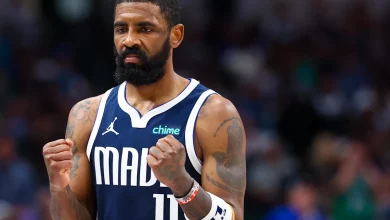A Texas man is charged with stalking Caitlin Clark after reportedly sending her frightening messages on social media.

In a disturbing development for the sports world, a Texas man has been charged with stalking Caitlin Clark, a prominent WNBA player, after allegedly sending her a series of frightening and threatening messages on social media. The case has raised critical concerns about the safety and well-being of professional athletes, particularly women, who face constant public scrutiny and, at times, become the targets of obsessive and harmful behavior by fans or individuals in their online communities. The situation also underscores the growing problem of cyberstalking and the dangers associated with social media platforms when they are misused to harass and threaten others.
Caitlin Clark, a standout basketball player who was recently drafted to the Indiana Fever as the first overall pick of the 2024 WNBA Draft, is one of the brightest stars in women’s sports. Known for her incredible scoring ability, basketball IQ, and leadership, Clark has gained a massive following, with fans admiring her skills and charisma both on and off the court. However, her newfound fame has also attracted unwanted attention. This recent incident has highlighted the increasing risks that athletes, especially women, face in the digital age, where online platforms can be used to exploit and harass them in deeply troubling ways.
This article will provide a detailed account of the stalking incident involving Caitlin Clark, discuss the broader implications of such harassment for female athletes, and explore how social media platforms and legal systems must evolve to protect individuals from these types of online threats.
Caitlin Clark’s Rise to Stardom and Increasing Public Attention
Caitlin Clark’s journey to becoming one of the most celebrated figures in women’s basketball has been swift and remarkable. During her time at the University of Iowa, Clark made history by breaking NCAA records and becoming the first player in Division I history—male or female—to record over 900 points, 200 assists, and 200 rebounds in a single season. Her performances in the NCAA tournaments have captivated basketball fans across the country, and she became a household name after leading the Iowa Hawkeyes to a national championship game appearance in 2023.
Clark’s remarkable talent on the court and her engaging personality off the court have earned her numerous endorsements, including partnerships with major brands and media outlets. She is not just a sports figure but a cultural icon, with a fanbase that spans the globe. But as Clark’s star has risen, so too has her visibility, and with that visibility comes an unfortunate downside—the potential for harmful behavior from individuals who take their admiration to extreme and dangerous levels.
In the case of Caitlin Clark, her rise to fame has not only meant increased attention but also the reality that she would inevitably become the subject of online harassment. The emotional and psychological toll that such behavior can take on athletes is often underestimated, but for Clark, the recent stalking case serves as a stark reminder of how invasive and disturbing online harassment can become.
The Stalking Incident: Alleged Messages and the Arrest of the Texas Man
According to reports, the stalking incident began when a Texas man allegedly began sending Caitlin Clark a series of frightening and unsolicited messages on social media platforms. The man, whose identity has been revealed as 31-year-old Christopher Perez, reportedly initiated contact with Clark online by sending multiple direct messages, some of which were described as concerning, intrusive, and highly inappropriate. Authorities believe that Perez’s online actions escalated over time, with messages that became increasingly aggressive and alarming.
In the messages, Perez allegedly made several threatening comments, expressing his obsession with Clark and demanding a personal relationship with her. The nature of the messages included disturbing content, including comments that alluded to knowing intimate details about Clark’s personal life and comments that made her feel unsafe. The messages reportedly intensified over a period of months, with Perez’s behavior becoming more erratic.
Clark, understandably distressed by these messages, eventually reported the harassment to her team, the Indiana Fever, and to law enforcement officials. Police in Indianapolis, where Clark resides and plays for the Fever, were able to trace the messages to Perez and subsequently arrested him on charges of stalking and harassment. He is facing serious criminal charges, including cyberstalking, which could result in significant legal consequences if he is convicted.
The arrest of Perez has sparked widespread concern about the safety of professional athletes and has brought attention to the troubling realities of harassment in the digital age. While Clark’s experience has had a swift legal response, many other athletes do not always have the same support, and incidents like these highlight the ongoing vulnerability that public figures, particularly women, face when dealing with obsessive and predatory fans or individuals.
The Psychological Impact of Stalking on Athletes
Stalking and harassment, especially through online platforms, can have serious psychological consequences for the victim. For Caitlin Clark, as for many other athletes who face similar situations, the psychological toll of being stalked can be overwhelming. While athletes are often expected to be resilient in the face of pressure, the mental and emotional effects of stalking and harassment can be just as debilitating as physical injuries.
The fear, anxiety, and trauma that come from being targeted by someone who refuses to respect personal boundaries can significantly impact an athlete’s well-being. Clark, like many other female athletes, has found herself at the center of public attention, and this unwanted attention has the potential to disrupt her sense of safety and personal space. In some cases, such experiences can affect an athlete’s performance on the court, leading to increased stress, difficulty concentrating, and a heightened sense of vulnerability.
Beyond the immediate effects on mental health, stalking can also create a sense of isolation and powerlessness for the victim. It’s important to recognize that the victim of stalking is not at fault. Unfortunately, many women athletes have reported feeling helpless when faced with harassment that occurs in a public, often online, space. The lack of privacy for athletes—coupled with the invasive nature of social media—only exacerbates these feelings.
For Caitlin Clark, as for many others, it’s crucial that athletes have access to mental health resources to navigate the trauma that comes with such harassment. Many organizations are now beginning to focus more on providing support systems for athletes who face these kinds of challenges, but there is still much work to be done to ensure that athletes are not only supported in their careers but also in their personal lives.
Cyberstalking: A Growing Threat in the Digital Age
The advent of social media and the increasing reliance on digital platforms for communication has made cyberstalking a growing problem. Cyberstalking refers to the use of electronic communication to stalk or harass an individual, often involving repeated and targeted messages, threats, or unwanted attention. With the proliferation of social media platforms like Twitter, Instagram, and Facebook, it has become easier for individuals to connect with celebrities and athletes, but it has also made it easier for those with harmful intentions to stalk their targets.
For athletes like Caitlin Clark, the accessibility and visibility provided by social media can be a double-edged sword. While platforms allow athletes to interact with fans and promote their brands, they also expose them to the risks of cyberstalking and online harassment. The line between a fan’s admiration and harmful obsession can often become blurred, and in cases like Clark’s, what may begin as harmless messages can escalate into something much more dangerous.
The ease with which individuals can remain anonymous online has also made it harder for law enforcement to track down stalkers or prevent harmful behavior. Social media companies have faced increasing scrutiny for their role in allowing harassment to persist on their platforms, and while many have implemented reporting systems and blocking features, these measures are often not enough to prevent the most extreme cases of cyberstalking.
As cyberstalking continues to grow as a threat, both legal systems and social media companies will need to implement stronger measures to protect individuals from online harassment. These may include better enforcement of anti-harassment policies, improved tracking of online activity, and more immediate responses to reports of stalking or abusive behavior.
Legal and Institutional Responses: How to Protect Athletes
Caitlin Clark’s case brings to light the crucial need for legal protections for athletes—especially women—who face stalking and harassment. In the United States, stalking laws vary from state to state, but many states, including Indiana, have specific laws that criminalize stalking and harassment, including cyberstalking. These laws are meant to protect individuals from unwanted attention, threats, and online harassment. However, the rise of social media has complicated enforcement, as stalking often occurs across multiple platforms, making it more difficult for law enforcement to track and prosecute perpetrators.
The legal system’s response to cases like Clark’s needs to be swift and robust to ensure that perpetrators face consequences for their actions. In this case, the arrest of Christopher Perez serves as a reminder that stalking and harassment are not tolerated in professional sports, and that athletes’ safety and security are paramount. However, more needs to be done to ensure that these types of incidents are prevented from occurring in the first place. Sports organizations, law enforcement, and social media companies must work together to create safer environments for athletes, offering them not only legal protection but also mental health resources and strategies for dealing with harassment.
The Importance of Awareness and Support Systems for Athletes
In light of this recent incident, it is clear that there is a need for increased awareness of stalking and harassment in sports. Caitlin Clark’s experience highlights a broader problem faced by many athletes in the public eye. It is crucial that organizations, including the WNBA, team management, and advocacy groups, provide resources and support for athletes dealing with harassment. More educational campaigns and training for athletes on how to handle online threats and how to protect their privacy would go a long way in preventing similar situations in the future.
Moreover, public awareness campaigns can play a key role in shifting the culture surrounding athlete fandom. Fans must be reminded that while it is natural to admire and support athletes, respecting their personal space and privacy is essential. The line between admiration and obsession can sometimes be hard to draw, but it is necessary for the safety and well-being of athletes that this line is clearly understood and respected.
Moving Forward: Ensuring the Safety of Athletes
As the investigation into the stalking case continues, Caitlin Clark and her team will likely continue to focus on securing her safety and ensuring her peace of mind. The legal consequences for Christopher Perez are still unfolding, but this incident has already raised significant questions about how to better protect athletes from harassment, especially in the digital age.
Ultimately, athletes like Caitlin Clark should be able to focus on their careers and their passion for the sport without fear of harassment or stalking. It is crucial that society, both within and outside of sports, works together to ensure that athletes are given the tools and protections they need to maintain their safety and mental well-being in an increasingly connected and public world.









